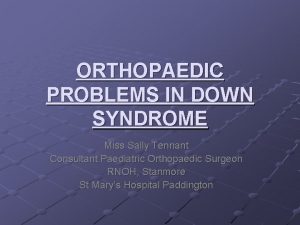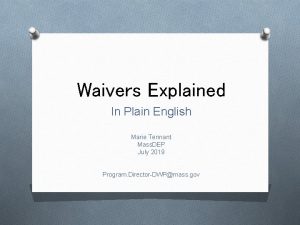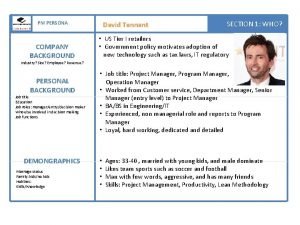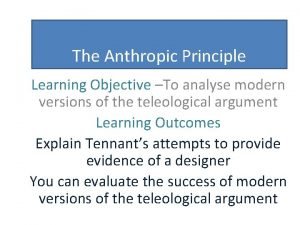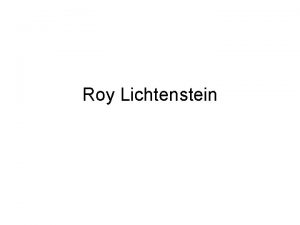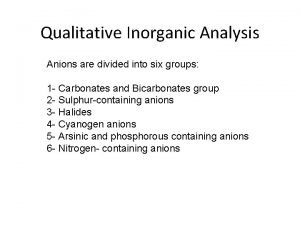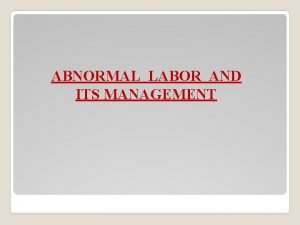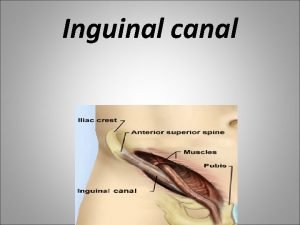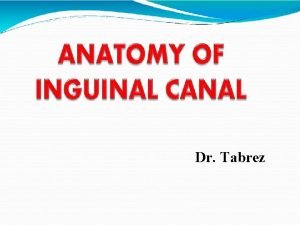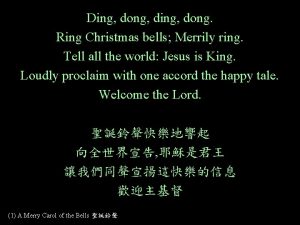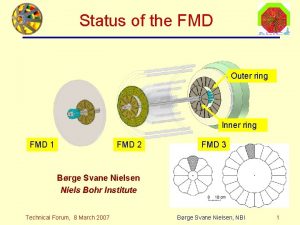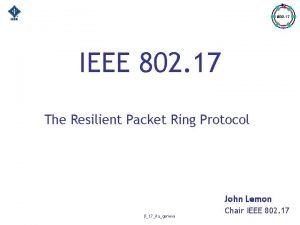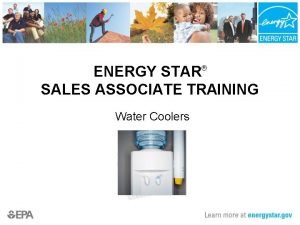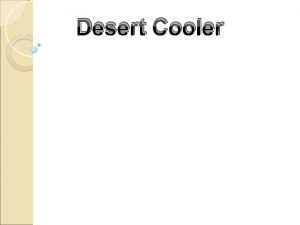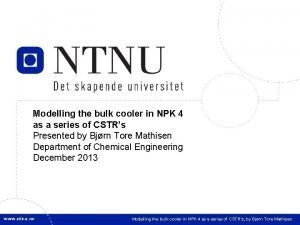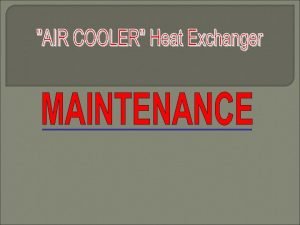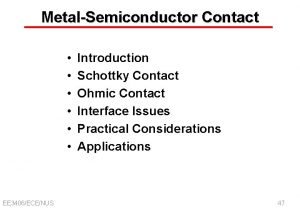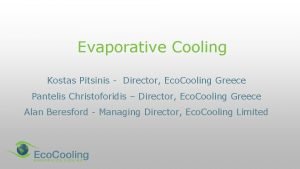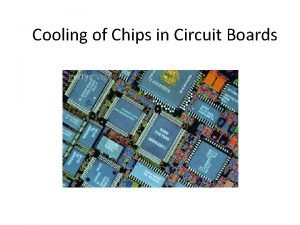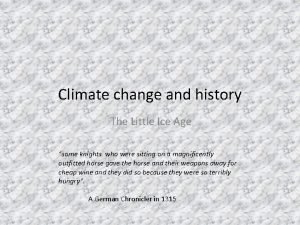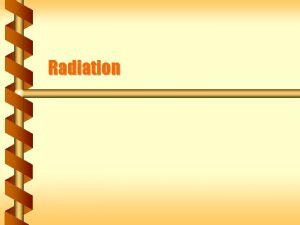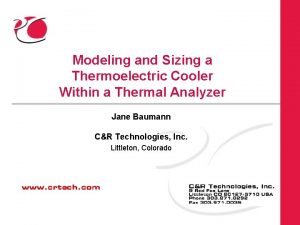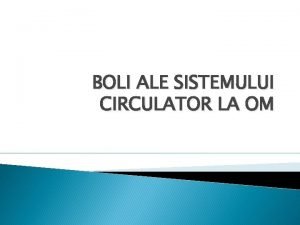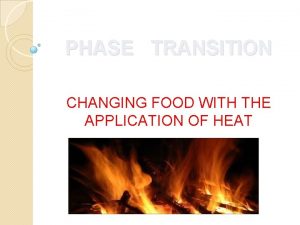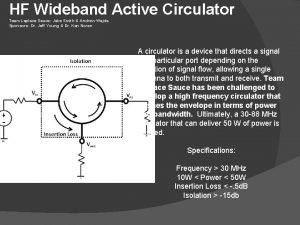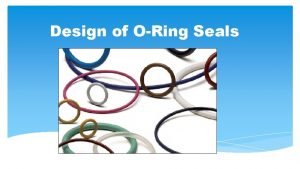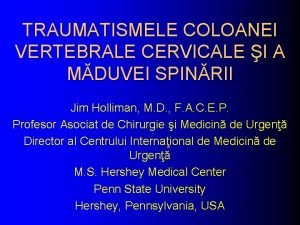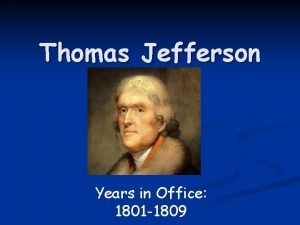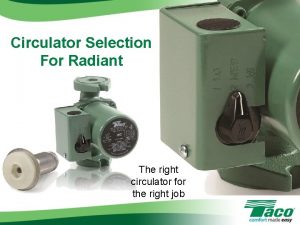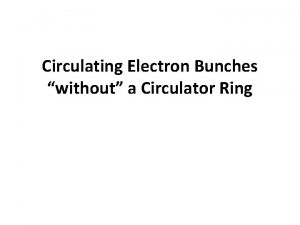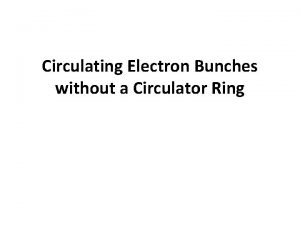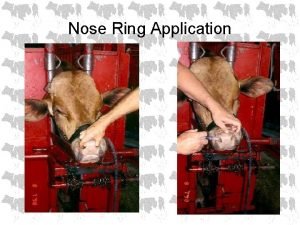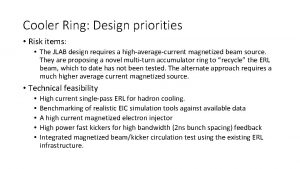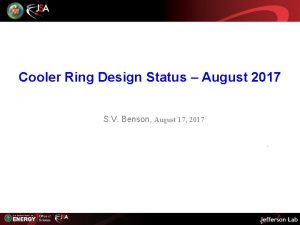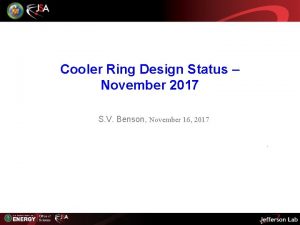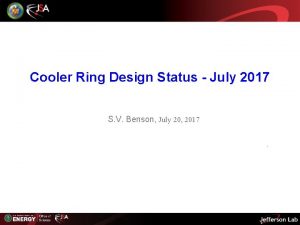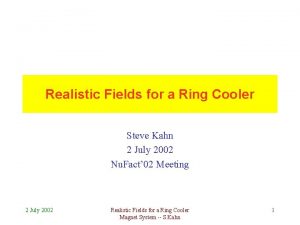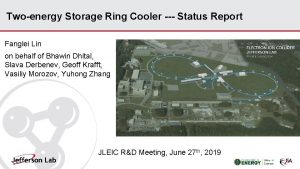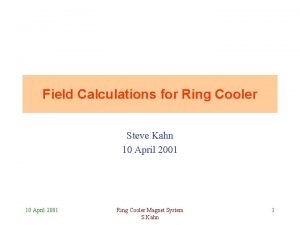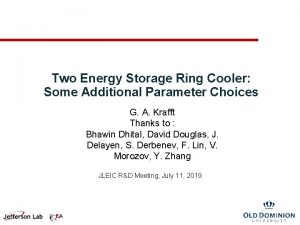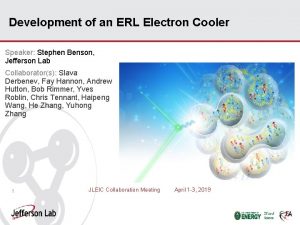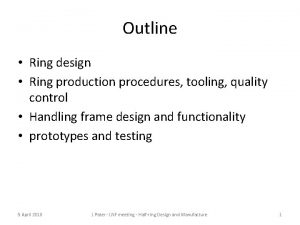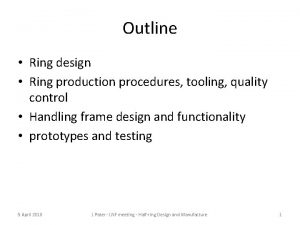Circulator Cooler Ring Design Speaker Chris Tennant Jefferson









































- Slides: 41

Circulator Cooler Ring Design Speaker: Chris Tennant, Jefferson Laboratory Collaborators: Slava Derbenev, David Douglas, Fay Hannon, Andrew Hutton, Rui Li, Bob Rimmer, Yves Roblin, Chris Tennant, Haipeng Wang, He Zhang, Yuhong Zhang JLEIC Collaboration Meeting Spring 2018, Jefferson Lab, March 26 -28, 2018

Outline • Why a CCR? ütransition from weak to strong cooling • What is the CCR? ücooling channel o drives system requirements (beam energy, emittance, match, distribution, etc. ) ürecirculation arcs o intersection of many beam dynamical processes übeam exchange o possible with development of fast kickers ücurrent status • Summary üpre-CDR readiness level 2

Background • initial design effort focused on “weak cooling” üsingle pass ERL ümoderate charge (420 p. C) üpreliminary injector design developed ügenerated ERL design with acceptable performance with “ideal” injected beam • in late 2016 the specifications were changed to “strong cooling” üextremely high charge (3. 2 n. C) üextremely high current via CCR (1. 5 A) üretain the ERL solution as a driver for CCR o relaxes average current burden on ERL in exchange for increased bunch charge 3

Weak Cooling magnetization flip ion beam cooling solenoid chirper magnetized gun de-chirper booster beam dump linac Parameter Injected momentum Momentum at cooling channel RF fundamental frequency Bunch repetition frequency Bunch charge Bunch length at cooling channel (full) Energy spread at cooling channel (rms) Cooling solenoid strength Normalized horizontal drift emittance Normalized Larmor emittance Value 5 Me. V/c 55 Me. V/c 952 MHz 476 MHz 420 p. C 2 cm / 66. 7 ps / 22. 9° 3× 10 -4 1 T 36 mm-mrad <19 mm-mrad (JLAB-17 -009) 4 arc flip solenoid

Strong Cooling ERL (bottom) magnetized gun chirper linac booster beam dump chirper dipole CCR (top) ion beam magnetization flip cooling solenoids magnetization flip septum DC & RF kicker CCR ERL DC & RF kicker it chirper dipole 5 DC & RF kicker rb unch o b d e t injec extract ed bun Beam Exchange (side) ch orb it chirper dipole harmonic kicker exchanges every 11 th CCR bunch between ERL and CCR

Background • top level requirements are “standard” for an ERL ügenerate, accelerate, and deliver to user a properly configured beam ürecover (possibly degraded) beam after use üpreserve beam quality, avoid instability and limit losses • unique features* of cooling systems: ümagnetized beam o axially symmetric transport ühigh charge o collective effects aggravated ülong bunch o length required for cooling exceeds linac phase acceptance üsmall momentum spread o susceptible to wake-induced distortion 6 *read challenges

Cooling Channel • the ion beam and electron beam co-propagate through the channel where thermal energy is transferred from the ions to the electrons and are “cooled” • separate the 60 m active cooling length into 4 × 15 m solenoid sections üneed to address field uniformity and alignment challenges B>0 B<0 Parameter Energy Charge CCR Pulse Freq. Bunch Shape Bunch Length Thermal emittance 7 magnetization flip I-transform magnetization flip B<0 B>0 Value Parameter 55 Me. V 3. 2 n. C 476. 3 MHz Beer can 2 cm (full) <19 mm-mrad Norm. Tran. Drift Emittance RMS Energy Spread (uncorr. ) Energy Spread (p-p corr. ) Solenoid Field Electron Beta in Cooler Solenoid Length Value 36 mm-mrad 3 x 10 -4 <6 x 10 -4 1 T 0. 37 m 4 x 15 m

Magnetization Flip Transformation • preserving ion polarization requires running solenoids with opposite signs • however, electron beam has a specific sign of angular momentum which must be matched to the sign of the solenoid • need to flip the magnetization between solenoids and ensure appropriate transverse match entrance exit 8

Recirculation Arcs • ERL has 360° of bending • CCR has 11 × 360° of bending • the CCR arc has the following requirements: ülocal axial symmetry – preserve magnetization üglobally isochronous – longitudinal match ülocally isochronous - manage CSR and m. BI ülocally achromatic – manage CSR and m. BI ühigh periodicity – suppress aberrations and error sensitivities ümoderate size – avoid space charge degradation • not easy to satisfy all conditions simultaneously 9

Arc Layout • design by D. Douglas (JLAB-TN-18 -009) • do not force the conditions of ühigh periodicity ülocal axial symmetry • start with a simple baseline arc, analyze and determine level of increased complexity required dipole quadrupole sextupole 10

Probing the Parameter Space • DIMAD ülattice design • elegant üCSR • GPT üspace charge üCSR • Bmad üCSR shielding • Vlasov-Solver 11 ümicrobunching • TStep üspace charge üCSR

Microbunching Gain • needs to be less than unity for multiple passes ütotal gain goes as gain(1 -turn)Number Passes • consider the gain for multiple turns in a “CCR ring” (two arcs put together) modest gain for 1 -arc ~ 5 12

Effect of CSR on Longitudinal Phase Space no CSR CSR “corrected” 13

RF Correction for 20 Turns • cannot compensate head/tail effects • will need to explore collimation schemes after 20 turns initial 14

CSR Shielding with CSR for sz = 4. 95 mm 15 with CSR + shielding

TStep – Multiturn Tracking • space charge only 16

elegant – Multiturn Tracking • CSR only 17

elegant – Multiturn Tracking • CSR with csrdrifts 18

Bmad – Multiturn Tracking • CSR with csrdrifts and with CSR shielding (5 cm) 19

Magnetization • quantify the magnetization (or lack thereof) as a function of turn number 20

Charge Scan 21 0. 4 n. C 0. 8 n. C 1. 6 n. C 3. 2 n. C

Beam Exchange v 1. 0 • reference orbit defined by injected/extracted beams üseptum bending field lies on axis of exchange region (septum wall above axis) üall bunches are deflected upward - with DC kicker - to clear elevated septum wall üexchanged bunches kicked downward via RF kicker back onto axis • sequence for recirculated beam üDC kick up + extraction kicker at (near) zero kick übunches follow orbit offset through exchange, clear septum, return to CCR axis at node downstream üDC kick up + injection kicker at (near) zero kick at node and re-steers bunch train to CCR reference orbit o IK cancels any remnant (x’-t) correlation from EK CCR IK & DC DC & EK it ERL dipole 22 b nch or u b d e inject extract ed bun ch orb it dipole

Beam Exchange v 1. 0 • sequence for injected beam üDC kick up + “pre-kicker” down o pre-compensates any (x’t) correlation induced by IK üon-axis through vertical achromatic translation up to plane of CCR → cross septum to bend onto CCR axis üon-axis transport to IK (down) and DC kick (up), merging with circulating beam • sequence for extracted beam üDC kick up + extraction kick down → on-axis transport to septum übend down and vertical achromatic transport to plane of ERL, bending onto plane of ERL ü“post-kicker” down + DC kick up o post-kicker cancels any bunch distortion (x’t correlation) due to EK CCR ERL IK & DC DC & EK DC & pre dipole 23 it b nch or u b d e inject extract ed bun Beam Exchange (side) ch orb it post & DC dipole

Twiss Parameterization • CCR back leg • ERL to CCR 24

Putting It All Together: “S 2 E” • incorporate beam exchange, recirculation arcs, cooling solenoids, magnetization flips • track distribution through entirety of the CCR • use reduced charge (1. 6 n. C) Simple Arc X (m) 15 m 0 Simple Arc pathlength = 194. 5973 m ~ 618 l. RF 4. 8 m 15 m 5. 4 m solenoid 15 m 4. 8 m solenoid 15 m solenoid -10 -40 -20 0 Z (m) 25 20 40

RMS Beam Sizes 26

Multi-Turn Tracking with Kickers • DC kickers only • 11 revolutions in CCR 1 2 3 4 5 6 7 8 9 10 11 • harmonic kickers only 1 2 3 4 5 6 7 8 9 10 11 • DC + harmonic kickers • 1 st bunch is extracted 27

Summary: Outstanding Issues • source • injector • merger • preserving magnetization • collective effects • realistic fields • CSR (E loss and DE/E growth) • preserving magnetization 28

Summary: Beam Dynamics Issues • CSR, space charge, m. BI: solved at lower charge, undemonstrated at high charge • beam breakup (BBU): well understood, need full system (S 2 E) to assess impact • halo: serious problem, not yet addressed ühalo formation effects: IBS, Touscheck, beam dynamical processes • ion trapping: potential problem (JLAB-TN-17 -024) • environmental wakes, impedances, etc. • collimation ünot demonstrated in CW operation • do not have a code with this combination of collective effects in this parameter range • these items represent only the things about which we know, not the things we know we don’t know 29

Summary: Pre-CDR Readiness • have initial designs for most of the major cooler sub-systems • process of putting them all together has begun • real analysis begins when pushing particles with relevant collective effects • goal for pre-CDR is to have a self-consistent picture of cooler – at reduced charge • still a long way to go for a mature system design… 30

• • • • Summary: Pre-CDR Documentation “Flipping Magnetization Helicity” (JLAB-TN-16 -035) “Transport of Magnetized Beams: Transformations with Rotational Symmetry and Reflections” (JLAB-TN-16 -044) “Electron Optics for Cooling Insertions” (JLAB-TN-16 -046) “Beam Optical Requirements for (and a Design Realization of) a Derbenev-Style Transverse/Longitudinal Em. Ex” (JLAB-TN-17 -008) “Progress Toward an ERL Driver for High Energy Bunched Beam Cooling in JLEIC” (JLAB-TN-17 -009) “ERL <=> CCR Beam Exchange Region Design, Revision 1. 0” (JLAB-TN-17 -012) “LSC-Induced Longitudinal Chirp In the JLEIC Cooling System” (JLAB-TN-17 -023) “Will There Be Ion Trapping in the Cooler ERL and CCR? ” (JLAB-TN-17 -024) “Beam Exchange Kickers and Magnetization: A Cautionary Tale” (JLAB-TN-17 -026) “Beam Exchange System Design Optimization” (JLAB-TN-17 -031) “A Simple Model for ERL/CCR Tracking With a QWR Kicker” (JLAB-TN-17 -033) “Beam Lifetime, Beam Loss, and Collimator Specifications 101: Ring Equilibrium Dynamics” (JLAB-TN-17 -038) “Estimates of Kicker-Generated Phase Space Distortion In the JLEIC Cooling System” (JLAB-TN-17 -052) “What Does(n't) A(n Ideal) Solenoid Do To A(n Ideal) Magnetized Beam? ” (JLAB-TN-17 -054) “Analysis of a "Simple Arc" for Use in the CCR for Strong Cooling in JLEIC” (JLAB-TN-18 -001) “A Simple (and Quite Possibly Incorrect) Description of Magnetized Beam Formation (That Gives the Right Answer Anyway. . . )” (JLAB-TN-18 -006) • “A Simple Achromatic/Isochronous CCR Arc Design ” (JLAB-TN-18 -009) • “Matching (Formerly) Round Magnetized Beams to Arbitrary Aspect Ratio Inside Solenoids ” (JLAB-TN-18 -010) • “On the Choice of Offsets for Halo Maps” (JLAB-TN-18 -018) 31 = 275 pages

Pre-CDR Outline 32

33

BACKUP 34

What is CSR? § mechanism: üfor a high brightness bunch is on a curved orbit, fields emitted from the tail can overtake and interact with the head of the bunch ütail loses energy, head gains energy (tail-head effect) üis an issue at all energies § the results are a redistribution of particles (in an undesirable way): ü projected emittance growth ü projected energy spread growth ü centroid energy loss 35 “bulk”

What is Microbunching? § initial density modulation can induce energy modulation due to the presence of short-range wakefields (e. g. LSC or CSR) § the energy modulation can be converted to density modulation via the R 56 in the beamline § process may result in an enhancement of the initial density modulation microbunching instability current l gain z impedance l R 56 energy 36 z

Deja-vu All Over Again • if the concept of a CCR rings a bell… JLAB-TN-12 -026 37 JLAB-TN-12 -027

Why Magnetized Electron Cooler? • At cathode immersed in solenoid, a gun generates almost parallel (laminar) beam state of a large size (electron Larmor orbits are very small compared to beam size) • This beam state is then transplanted to the solenoid in cooling section (while preserving the canonical emittances: the drift and the Larmor emittances) • The solenoid field can be controlled to make e-beam size properly match the ion beam size Magnetization results in the following critical advantages (compared to a non-magnetized gun/cooling solenoid): • Tremendous reduction (by a factor 20 – 30) of the regional and global deleterious Space Charge transverse impact to dynamics in CCR (tune shift) • Strong mitigation (suppression) of the CSR microbunching/ energy spread growth • Suppression of deleterious impacts of high electron transverse velocity spread and short-wave misalignments to cooling rates (thanks to ion collisions with “frozen” electrons at large impact parameters) 38

Initial Beam Distribution • uniform transverse (horizontal and vertical) distribution • temporally, flattop distribution with Gaussian edges enx=eny= 36. 87 mm-mrad 39 s. DE/E = 3× 10 -4 sz = 2 cm (full)

Longitudinal Match • use longitudinal match developed for ERL-based weak cooling üoff-crest acceleration bunch of modest length üdebunch, dechirp during transport to cooling system üreplace “ERL cooling system” with CCR ürechirp, rebunch during return transport for energy recovery ürecover bunch of modest length with energy compression of chirp 40

TStep with Collective Effects space charge + CSR 41
 Miss sally tennant
Miss sally tennant Stephen hawking
Stephen hawking Celia tennant
Celia tennant Marie tennant
Marie tennant Background di una persona
Background di una persona Aesthetic principle tennant
Aesthetic principle tennant Roy lichtenstein whaam
Roy lichtenstein whaam How are anions divided into groups
How are anions divided into groups Strong no in c
Strong no in c Content of hesselbach triangle
Content of hesselbach triangle What is the inguinal region
What is the inguinal region Ding dong ding dong christmas bells are ringing
Ding dong ding dong christmas bells are ringing Ring christmas bells ring them loud
Ring christmas bells ring them loud Inner ring and outer ring
Inner ring and outer ring Token ring and resilient packet ring
Token ring and resilient packet ring Addico water cooler
Addico water cooler What is meant by desert cooler
What is meant by desert cooler Npk cooler
Npk cooler Broken heat exchanger
Broken heat exchanger What is dangling bond
What is dangling bond Eco cooler test
Eco cooler test One way to cool chips mounted on the circuit boards
One way to cool chips mounted on the circuit boards North atlantic oscillation
North atlantic oscillation Innowave chiller
Innowave chiller Hot metal contracts as it grows cooler
Hot metal contracts as it grows cooler Sinda fluint
Sinda fluint Flow of energy vs flow of matter
Flow of energy vs flow of matter Boli ale sistemului circulator referat
Boli ale sistemului circulator referat Emersion circulator
Emersion circulator Hf circulator
Hf circulator Sangele mamiferelor este format din
Sangele mamiferelor este format din Anatomia sistemului circulator
Anatomia sistemului circulator Blatterfein system of maxillary designing
Blatterfein system of maxillary designing 4-bit synchronous counter using t flip flop
4-bit synchronous counter using t flip flop Static crush seal
Static crush seal Jeffersons justifications
Jeffersons justifications Irb portal jefferson
Irb portal jefferson Coloana cervicala fractura jefferson tip 4
Coloana cervicala fractura jefferson tip 4 Thomas jefferson resume
Thomas jefferson resume Thomas jefferson child hood
Thomas jefferson child hood What was thomas jefferson foreign policy
What was thomas jefferson foreign policy Benjamin franklin bottle project
Benjamin franklin bottle project
